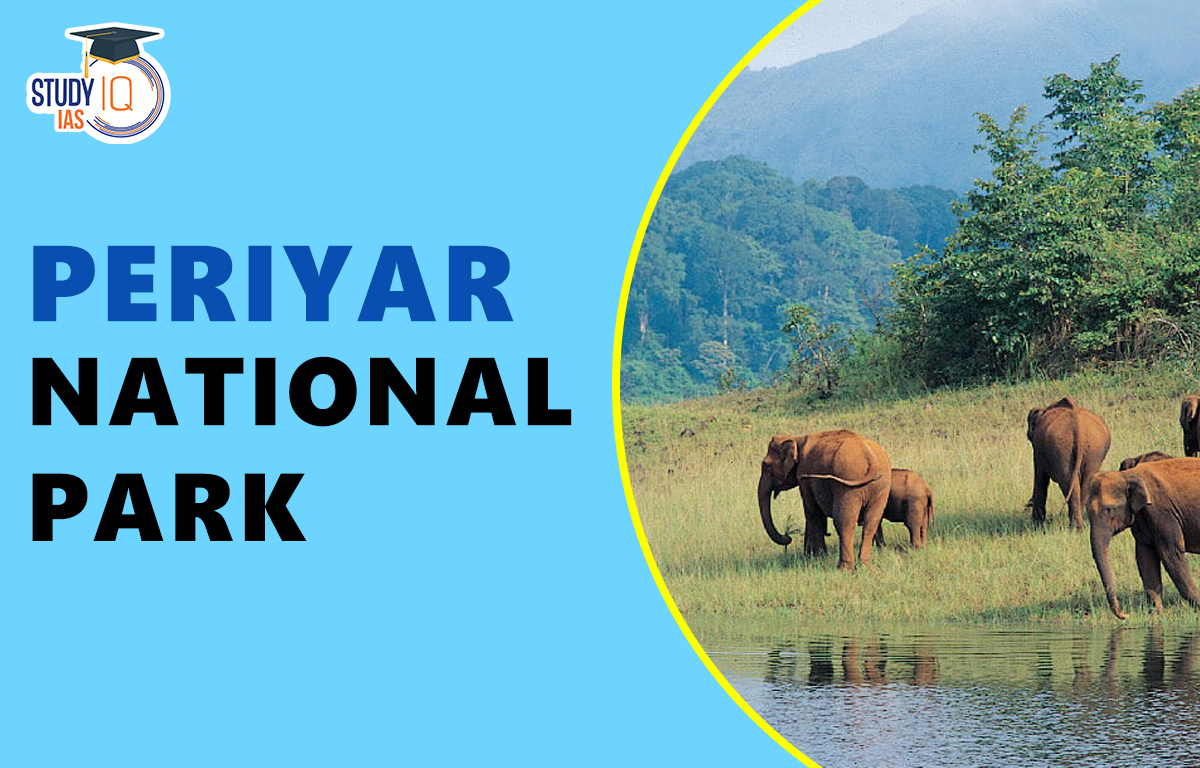Table of Contents
Periyar National Park
In Kerala, there is a protected wildlife sanctuary called Periyar National Park. The National Park is located in the Southern Western Ghats’ Pandalam Hills and Cardamom Hills. Periyar National Park is located in Kerala, India’s Pathanamthitta and Idukki regions. The Pamba and the Periyar, two significant rivers that cross the forest, help the local flora and fauna to survive. The UPSC Syllabus includes periyar National Park and all national parks as a significant topic of Environment subject. The UPSC Mock Test can help candidates prepare for the exam with more precision.
Periyar National Park History
When the Mullaperiyar Dam was constructed in 1895, Periyar National Park was created. The artificial lake in the valley was made possible by the dam that was constructed across the River Periyar, which also created a local water reservoir. The reserve was used by the Royalty as a shooting ground in the 18th and 19th centuries. At Edapalayam Lake Palace, all of the regal visitors gathered.
The Periyar Lake Reserve was the name given to the areas encircling Periyar Lake by 1899, when they had been designated as forest reserves. To stop tea plantation cutting and killing of animals, this was done. The region around Periyar Nellikkampatty Game Sanctuary was given that name in 1934 by S. C. H. Robinson, who was the first game warden and later became the Maharaja of Travancore. In order to counteract the declining wildlife population, the region was made a protected wildlife sanctuary in 1966.
The Central Government’s Project Tiger, which had started in 1972, had Periyar included by 1978. It received the designation of national park in 1982. The Central Ministry of Environment and Forests started the ambitious Project Elephant in 1992, using Periyar National Park as its launching pad. The India Eco-Development Project was begun in the reserve in 1996 to protect the ecosystem. The refuge had been split into Periyar East and Periyar West by the year 2001.
Also Read: Eravikulam National Park
Periyar National Park Feature
One of India’s 27 tiger sanctuaries is Periyar. Thekkady or Periyar Wildlife Sanctuary are additional names for the area. The elephant and tiger sanctuaries in the park are well-known. The protected region covers 925 km2, roughly. The Park is renowned for the variety of animals and birds it is home to. The abundant fauna includes elephants, tigers, sambars, gaurs, leopards, wild dogs, barking deer, mouse deer, monitor lizards, and a diversity of birds and reptiles.
Thekkady’s artificial lake, which has been around for 100 years, is the centrepiece of the sanctuary and is distinguished by its thick Western Ghats forests and wild elephant population. Only a few sunlight rays can penetrate the thick canopy of tropical evergreen trees that covers many of Periyar’s deep valleys. When completely grown, these trees can reach incredible heights of up to 100–140 feet.
In order to preserve the region’s biodiversity and stop tea estates from encroaching, the Maharaja of Travancore, Chithira Thirunal Balarama Varma, designated it a game reserve (Nellikkampatty Game Sanctuary) in 1934. In 1950, it received a designation as a wildlife refuge (Periyar Wildlife Sanctuary). After being a part of the Central Government’s Project Tiger programme in 1978, the sanctuary was given the new moniker Periyar Tiger Reserve.
The reserve became a component of Project Elephant, which was started by the Central Ministry of Environment and Forests in 1992 to safeguard populations of wild Asian elephants roaming freely in different Indian states. In 2004, the 148 km2 Goodrical Range was included in the reserve.
Periyar National Park Topography
The heavily undulating terrain of the Periyar Tiger Reserve ranges in height from 100 metres (Pamba valley) to 2016 metres (Vellimala) above sea level. In the Periyar Tiger Reserve, some of the prominent summits include Pachayarmala, Vellimala, Kottamala, Sunderamala, Chokkampetti mala, and Karimala.
The Periyar Tiger Reserve is traversed by the Periyar River, which rises in Chokkampettimala and runs north. ( Periyar National Park). The Periyar River’s name served as the inspiration for the reserve’s designation. Mullayar and Churakkottayar are two of the Periyar River’s main branches. The Pamba and Azhutha rivers, which comprise the Periyar Tiger Reserve’s western boundary, drain the western portion of the reserve.
Periyar National Park Geology
The granites and gneisses that makeup Periyar’s subterranean geological formations predominate. Lower portions of the Periyar Tiger Reserve contain laterite. Due to the influence of dissolved laterite and gneisses, the soil in the Periyar Tiger Reserve is primarily fine loamy. The soil is coarser and contains a lot of quartz gravel, which is made from crystalline rock, in Periyar’s higher elevations. Acidic earth can be found in Periyar National Park.
Periyar National Park Climate
Both the South-West and the North-East monsoons affect the Periyar National Park, with rainfall levels peaking in July and falling to their lowest in January. 2500 mm of rain occurs annually on average.
Periyar National Park Flora
Periyar National Park’s flora is made up of tropical evergreen, semi-evergreen, and moist deciduous woods. Other timbers include Teak, Banyan, Sacred fig, Royal poinciana, Kino, Rosewood, Sandalwood, Jacarandas, Mangoes, Jamun, Tamarind, Bamboos, Gloriosa lily, and others.
Periyar National Park Fauna
Among the other creatures that can be found in the Periyar Sanctuary are wild pigs, sambar, gaurs, mouse deer, dole or barking deer, Indian wild dogs, and tigers. At the moment, there are thought to be 40 tigers in the Periyar National Park. In addition to the uncommon lion-tailed macaque, Periyar is home to the Nilgiri langur, Gee’s golden langur, Common langur, and Bonnet macaque. The elusive Nilgiri Tahr, which is rarely seen but valued for its existence, is also believed to reside in Periyar.
Tiger, Gaur, Elephant, Sambar, Mouse Deer, Barking Deer, Indian Giant Squirrel, Travancore Flying Squirrel, Sloth Bear, Indian Wild Dog, Wild Pig, Nilgiri Tahr, Lion-tailed Macaque, Nilgiri langur, Nilgiri marten, Gee’s Golden Langur, Common Langur, Bonnet Macaque, Nilgiri langur, Common Lang. The Nilgiri wood pigeon, Blue winged parakeet, Nilgiri flycatcher, White-bellied blue flycatcher, Malabar grey hornbill, Racket-tailed Drongos, Kingfishers, Darters, Cormorants, Great hornbill, Brahminy kite, Nilgiri thrush, and others are among the birds. Other reptiles include striped coral snakes, monitor lizards, pythons, king cobras, Malabar pit vipers, and pythons.
Periyar National Park Major Attraction
The major attraction of Periyar National Park is:
| Name | Details |
| Kumily | The ideal place to take in the serene surroundings of Kerala’s spice plantations is the town of Kumily, which is only 4 km from Periyar. |
| Cardamom Hills | Don’t miss the breathtaking cardamom slopes when you’re in Periyar. |
| Boat Cruises | The best method to see the protected forests in Periyar Sanctuary is by boat cruise. |
| Periyar Lake | The reserve is called after this lake, which is a part of the sanctuary area. To get a complete perspective of the sanctuary, visitors can take a boat ride around the lake. |
| Mangla Devi Temple | Thekkady is 15 miles away from the Mangla Devi Temple. The sanctuary, which is located on the border of Tamil Nadu and Kerala at a height of 1337 meters, draws a lot of pilgrims. In this 2000-year-old temple, prayers are only conducted on a full moon day between April and May. |
| Pullumedu | Pullumedu, which is 43 kilometres from Thekkady, is renowned for its lush greenery and wildlife reserves. Tourists can also explore the nearby Shri Ayappa Temple and Makara Jyothi Temple. |
Periyar National Park UPSC
The park serves as the primary watershed for the Periyar and Pamba, two significant rivers in Kerala, and is a repository for uncommon, endemic, and endangered plants and animals. The area is also known as Thekkady or the Periyar Wildlife Sanctuary. It is situated along the boundary with Tamil Nadu high in the Cardamom Hills and Pandalam Hills of the south Western Ghats. Students can read all the details related to UPSC by visiting the official website of StudyIQ UPSC Online Coaching.


 World Oceans Day 2025, History, Theme, S...
World Oceans Day 2025, History, Theme, S...
 World Environment Day 2025, Theme, Histo...
World Environment Day 2025, Theme, Histo...
 Unemployment Rate in India, Current Rate...
Unemployment Rate in India, Current Rate...





















